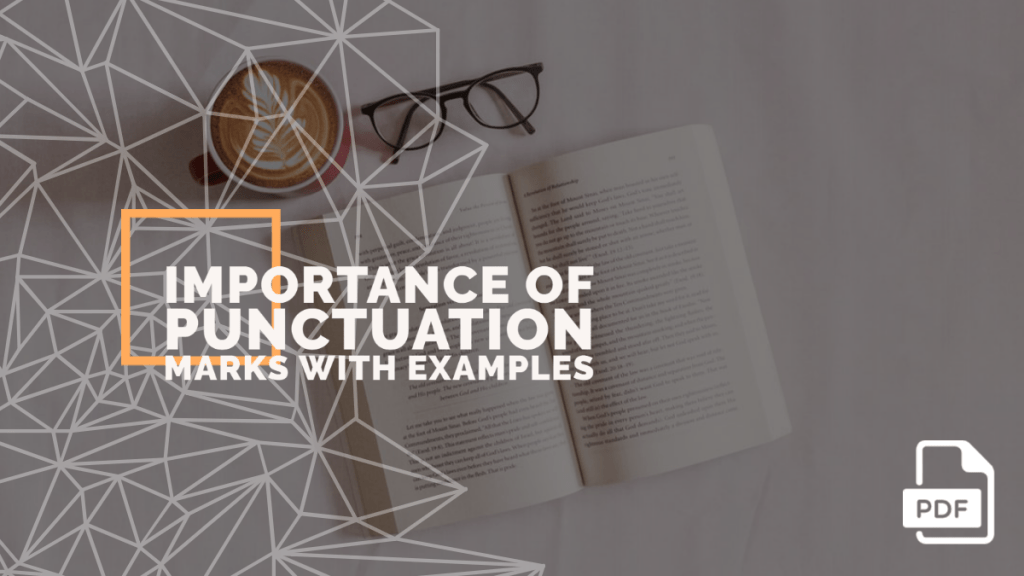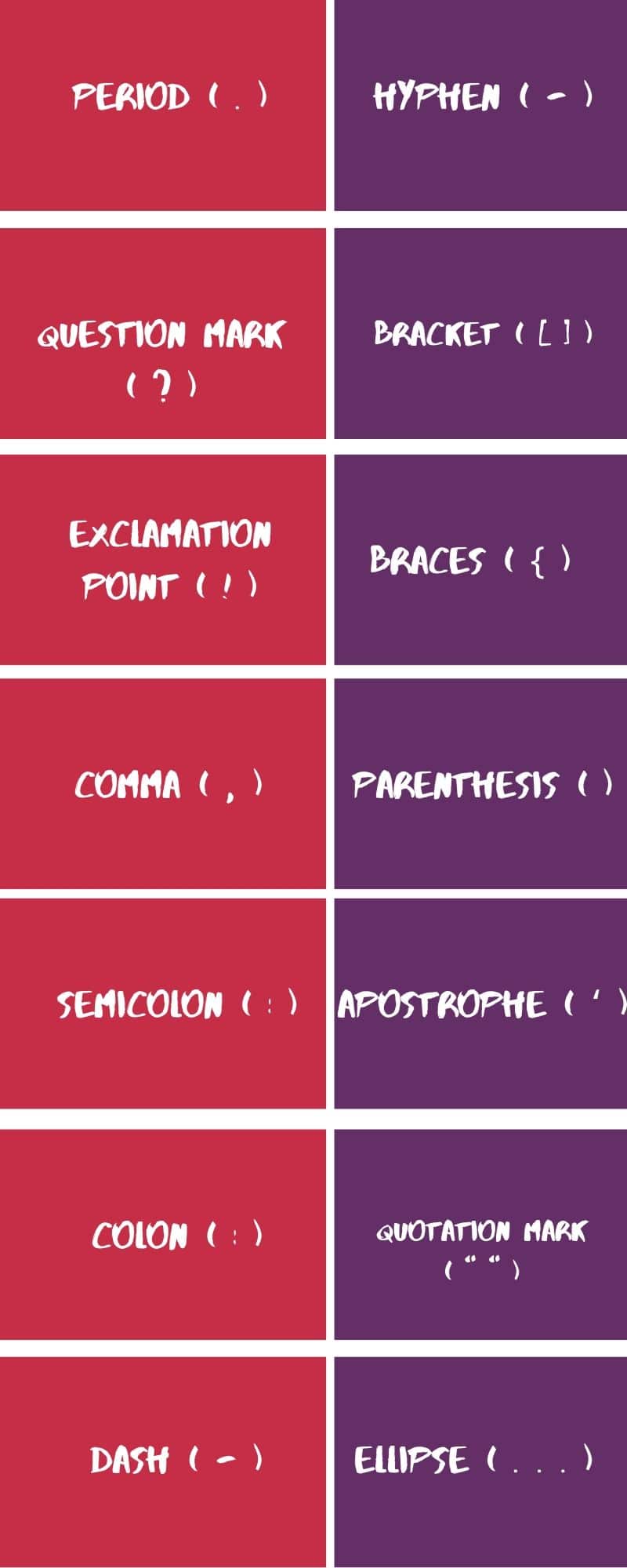Importance of Punctuation Marks with Examples [PDF]
The information presented here will explain the Importance of Punctuation Marks with Examples and how to use them in your writing. To download the lesson in PDF format, please find the downloadable link attached below in the article.

Most people do not like formal writing and they certainly don’t like to learn about the rules of punctuation.
However, if a person wants to communicate effectively, they will have to learn how to use proper punctuation and basic grammatical rules. [I already wrote a complete guide Parts of Speech in English Grammar, you may check this resource to strengthen your basic English grammar]
Knowing how to use punctuation will keep a person from looking illiterate when they communicate messages and it will also help to give some credibility to their written information.
list of Punctuation Marks and Symbols
In general, there are 14 Punctuation marks are in English Grammar and those are:
- Period ( . )
- Question Mark ( ? )
- Exclamation Point ( ! )
- Comma ( , )
- The Semicolon ( : )
- The Colon ( : )
- Dash ( – )
- Hyphen ( – )
- Bracket ( [ ] )
- The Braces ( { } )
- Parenthesis ( )
- Apostrophe ( ‘ )
- Quotation Mark ( “ “ )
- Ellipse ( . . . )
I will explain all these 14 Punctuation marks below on this article.
Take a Look on this Infographic:

1. The Period ( . )
The period is the best-known punctuation mark in writing. This particular mark is used at the ending of a sentence.
It is designed to keep sentences from running on into long passages. Periods were not used that often in the past.
In the olden days, people had a tendency to write lengthy passages. Run-on sentences just reflected how people communicated and reasoned. In modern times, people talk in short and quick terms. So, periods are used with more frequency since sentences are a lot smaller.
Here are some examples of how to use a period:
- The couple went to the movies to see the latest superhero film.
- The young lady had a graduation party.
- Pedro and Bubba ate tacos and fried chicken by the fruit stand.
2. The Question Mark ( ? )
When people write questions they need a way to make them different from a standard sentence.
Remember, a standard sentence just relays information or facts, just explains something or tells people what is happening.
However, a question makes inquiries or seeks to find something out. Sometimes questions are used to make people think or reflect.
A question mark is used in writing to alert the reader that they should be trying to figure out or answer what they are being asked.
Here are some examples of how to use a question mark:
- How many times did I tell you to clean your room?
- Did you go to work today?
- Who is the president on a one-hundred-dollar bill?
3. The Exclamation Point ( ! )
The exclamation point simply alerts a reader that someone is angry, shouting, really upset, giving someone or something a command, threatening, startled or they are trying to emphasize [External Link] something.
It is not commonly used in writing because it would just make people think that the writer is very angry about a subject or issue or that they are transmitting hate, dislike or chaos to the reader.
Exclamation points are used with caution and are rare in writing.
Here some examples of how to use an exclamation point:
- America is a materialistic country!
- I told you to get off my lawn before I call the police!
- Bro, you talking to me! You about to get dealt with!
4. The Comma ( , )
The comma separates elements and ideas within a sentence. They are used to keep separate words or pieces of information from running together. There are multiple ways to use commas. The three basic ways will be presented here.
Here are some examples of how to use commas:
- Mindy played outside, ate ice cream with her dog and played on her computer until midnight.
- Jeremiah, can you come here, please? I want to tell you that I’m sorry.
- My team scored 12 goals, and I made 10 of them.
5. The Semicolon ( : )
The semicolon is designed to join to separate clauses.
Here is are some examples of how to use a semicolon:
- I will go to the coffee shop; French espresso is my favorite drink.
- The kids like to eat eggs and toast in the morning; make sure to use cheese with the eggs.
- Mia went to Cardi’s house for a sleepover; many kids from the neighborhood are doing the same thing.
6. The Colon ( : )
It is often used for emphasis, when joining two sentences where the second emphasis the first and after a word that introduces an explanation, quotation, series or example.
Here are some examples of how to use semicolons:
- I will go to the store: when I get out of bed.
- She loved only one thing more than her husband: her blueberry popsicles.
- He had to gather supplies for his garden: spade, flower pots, seeds, and a rake.
7. The Dash ( – )
The dash is used to separate words into statements. There are two types of dash. One type is known as “en” and the other is known as “em”.
Here is an example for each one:
- From 1883 – 1897, the evil vampires raged through the land turning everyone into the undead. This example is for the en dash.
- The New Jersey Gamblers football team is the greatest in the world – no one can beat them! This is the “em” dash and it is often used to emphasize a point.
8. The Hyphen ( – )
The hyphen is used to join certain words together. For example, 10-years-old, part-time, well-known, est.
9. The Bracket ( [ ] )
The bracket is used for emphasis.
Here is an example of how to use a bracket:
- That [mean boy] ate my Takis and I was very mad.
10. The Braces ( { } )
Braces are often utilized by writers to show that certain information belongs together. They are not commonly used in basic writing [External Link].
Here an example of how to use braces:
- The configuration of the mathematical formula is displayed as {3n(e=mc2) x 8.5% [4 + 6.8^4]} rounded to the nearest cube.
11. The Parenthesis ( )
Parenthesis are typically used for qualifying marks. They are also used to contain further thought.
Here is an example for parenthesis:
- The ugly cat (who roams the street in the daytime) likes to sneak into homes and bite people’s dogs.
12. The Apostrophe ( ‘ )
When a writer wants to omit letters from a word, display the possessive case of a word or form the plural of a lowercase of letters; they use the apostrophe.
Here are some examples for the apostrophe:
- That kid’s parents are really mean.
- Don’t bit the hand that feeds you.
- Jessica didn’t dot her I’s or cross her t’s and that is why she lost the contract.
13. The Quotation Mark ( “ “ )
Quotation marks are used to emphasis unusual words or they can be utilized for quoting a person or show the begging or end of passage.
Here are some examples of quotation marks:
- “Justin, I need you now.” Said Selena as she woke up from her dream.
- Those people are very “politically correct” if you know what I mean.
14. The Ellipse ( . . . )
Ellipses help to keep writing brief and they are also used to jump from one phrase to another.
Here are some examples of how to use an ellipse:
- “I told you, that I want to nag at you all day and furthermore . . .”
- The woman nagged her husband all day, all night when he ate dinner when he . . . until he could no longer tolerate her presence.
A Must Watch Video Lesson on Punctuation:
This is a complete overview of the list of punctuation marks that are commonly used in English writing. The punctuation examples presented here can be used to improve any person’s writing ability and their ability to master the English language.
Liked this article? If so then don’t forget to share this stuff on social media and with your friends.
References [External Links]:
- Importance of Punctuation in Research Papers (Part 1) – Enago
- The Importance of Punctuation in English- Lingoda
- Punctuation | English Grammar | EF